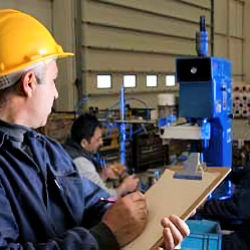Look Around Your Workplace
If you look around your workplace, you may be able to locate a few hazardous conditions or work practices without too much trouble.

Did you know that at any time an OSHA inspector can enter your corporate front door to begin a comprehensive inspection? What would OSHA find? What does OSHA look for?
With those questions in mind, wouldn't it be a smart idea for someone in the company to proactively play the role of an OSHA inspector? That's what we're going to talk about in this module. To start, let's look at some basic steps in the hazard identification and control process.
Step 1 - Identifying Hazards
The first step in the process is to identify hazardous conditions, unsafe behaviors, and system weaknesses that might result in accidents (and OSHA citations). The safety inspection process and observation are two effective hazard identification tools.
Step 2 - Analyzing Hazards
Once hazards are identified, we need to analyze them. To make sure the analysis process is successful, it's important to assume all hazards can be prevented, eliminated, reduced, or controlled. The Job Hazard Analysis (JHA) is an excellent tool for analyzing the hazards inherent in specific jobs.
Step 3 - Controlling Hazards
Once you finish analyzing hazards, you need to eliminate or mitigate them. A systematic strategy, called the "Hierarchy of Controls," is an effective approach to do that.
Throughout the rest of this module, we'll discuss how to identify, analyze, and control hazards to ensure a safe workplace and prevent employees from getting hurt or sick on the job.
Knowledge Check Choose the best answer for the question.
5-2. What is a systematic strategy to eliminate or mitigate hazards?
You forgot to answer the question!
